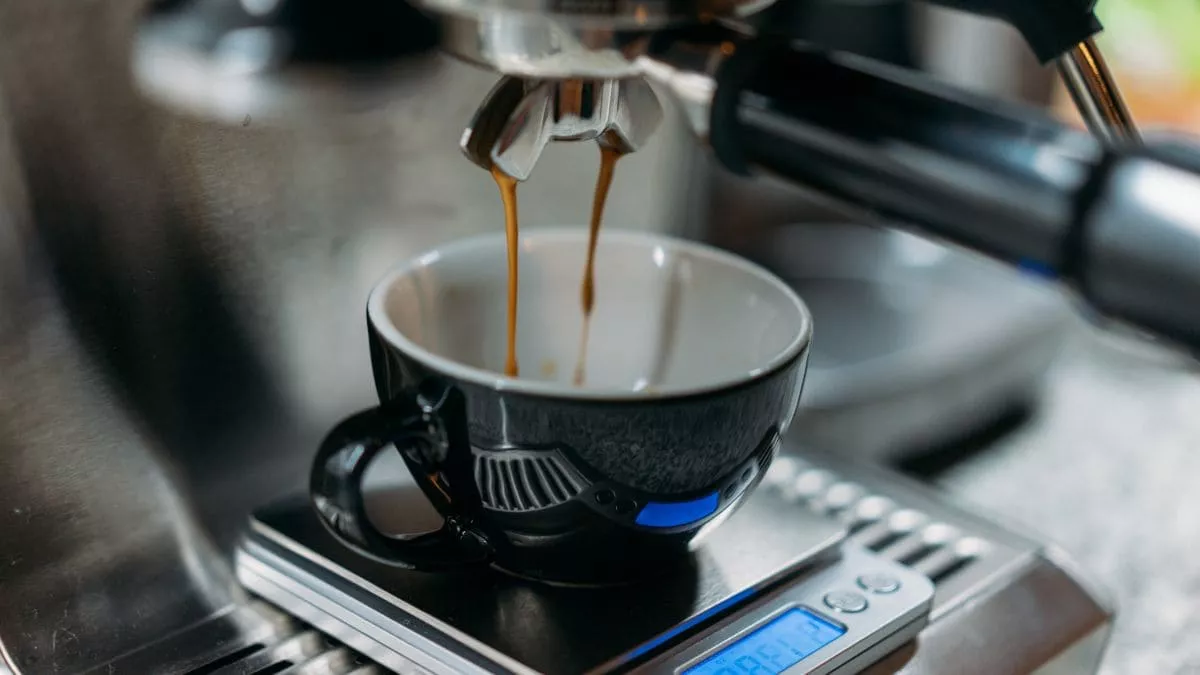
The ideal brewing time of an espresso machine is 10 to 20 seconds. If your coffee machine takes longer to brew your coffee, and espresso is dripping slowly, it’s a sign that other issues are at play. However, you can fix a slow dripping espresso machine easily.
Why is espresso dripping slowly
What you can do is slightly increase the grind size, clean the basket, and put less coffee in the basket, if nothing works, check for pressure issues, as well as clogging symptoms within the basket, conduits, and different other components.
Below you can find an in-depth guide for each of the potential reasons, fixes, and some bonus tips.
1. Grind size is too fine
If you take two glasses, filled one with little stones, and the other with soil, once you pour water on top of each, you will notice that the stones allow water to flow much quicker. The sample principle applies to coffee grinds.
If the coffee is finely ground, the particles can clump together tightly, preventing the water from dispensing at the required speed. Eventually, your espresso machine starts dripping slowly.
Fix: Every espresso machine has a specific grind size. So you need to make sure you get the right grind texture.
First, start from the default values specific to your espresso machine, and if your shots are dispensing slowly, slightly increase the grind size, make a test shot after every grind change, and check how fast your espresso is dripping. When it comes to espresso, some simple tweaks make a huge difference.
2. Overfilling the basket with coffee
If you overdose the puck with coffee grounds, density will increase, and water will take more time to dispense.
In addition, extra grounds in the coffee basket absorb all the water, leaving little water to extract the essence.
To put it into perspective, the extraction begins after the coffee grounds are completely soaked. So, when the particles use up the water during absorption, not much is left for extraction, your machine will therefore start dripping slowly.
Fix:
- Always use a compatible filter basket, and make sure the dose is consistent with the specifications.
- Try using a single wall filter (Non-pressurized) basket, especially when brewing one shot.
- Use a distributer/tamper, especially if you’re a beginner.
3. Blocked filter
If your espresso machine is dripping slowly, one of the first things you should check is the filter. Dirt and other particles may clog your filter and block the flow of extraction.
Fix: Clean the filter with vinegar and water, or use a specific solution depending on your machine type and brand. Likewise, If you use hard water in an espresso machine, scale and mineral deposits accumulate over time. Descale your espresso machine frequently to avoid slow dripping issues.
Read on as I will go into more depth about the cleaning and descaling in the latter part of the article.
4. Clogged Group head
The group head dispenses water from the boiler into the coffee filter basket, it is one of the most crucial parts to look at if your espresso has dispensing issues. When the group head is clogged, water will not be able to move freely, hence halting your espresso’s normal extraction speed.
Fix: Clogging occurs primarily due to scale formation and coffee residue build-up. To fix the issue, start by descaling your coffee machine, then make sure to clean it more regularly.
5. Total Open Area in Baskets
The total number of holes in the coffee basket as well as the average size of each hole is referred to as the ‘Total open area’ or TOA of the basket. So it makes sense that the greater the TOA is, the faster your espresso dispenses.
If your espresso drips slowly, it might be due to the design of your filter basket.
Fix: Always use a compatible basket in size and design. Take the VST basket, for instance: Most espresso machines are compatible with a 58 mm VST basket. However, if you go for a 57 mm or 54 mm basket, your espresso machine will start dripping slower.
6. Wrong operating pump pressure
The operating pump in your espresso machine forces the heated water at a higher pressure to compress the coffee grounds. If the pressure in the pump is low, expect your espresso shot to dispense very slowly.
How do identify the problem?
Check on the pressure gauge monitor. The optimal pressure of the pump should be anywhere between 7 bars and 10 bars.
Fix: Check for loose wires, air pockets, and clogs. You might need some technical assistance to resolve the pressure issue.
7. The O-Ring is damaged
O-rings are gaskets used to tightly seal in liquids and prevent any potential leaking within your portafilter. If the O-Ring has worn out or was damaged in any way, the water flow will significantly be disrupted, resulting in slow dripping.
An early sign of the gasket seal failure is when your portafilter will not lock in place as tightly as it used to, you will notice some wiggle room is now present. A sure sign is when you start noticing droplets of water dripping over and around the sides.
Fix: You’ll have to replace the faulty O-Ring, which is located under the group head. Pull off the defective seal using a screwdriver and clean the area thoroughly, removing any residue or excess grounds. Lace the seal with a food-friendly lubricant, then carefully lock it into place with its indented side facing up.
8. Broken valves
All espresso machine boilers have safety valves. The problem occurs when an increase in pressure breaks these valves, rendering them unable to stabilize the boiler pressure. And as we’ve established before, any decline in pressure will cause your shots to dispense abnormally slower.
Fix: The safety valves are located within the caps of the boiler. You need to replace the caps if your valves break or wear out.
9. Defective conduits
Coffee machines have tubes and pipes carrying the water from the reservoir right into the basket. Any rust, scale, or dirt formation can either clog or even damage these conduits, resulting in a disrupted (Sometimes even halted) water flow.
Fix: It can take some ‘digging’, but you will need to replace the damaged pipe or tubing system. Start by removing the reservoir, the back, and the top covers. You will then be able to get a full view of the pipe. Check if there is any clogging or visible damage before moving forward with the replacement.
Generally, it is recommended to change the pipe once every two to three years, depending on the manufacturer.
10. Air pockets
Air pockets occur if you operate your espresso machine without water. Air bubbles or air pockets are then formed within the machine, blocking the water flow the next time you start the machine.
Fix: You need to purge the air bubbles. Here are some steps to remove air pockets from your coffee machine:
- Remove the filter connected to the inlet hose.
- Take a large syringe or a turkey baster. Load it with water.
- Connect it to the inlet hose. Ensure that you seal it properly while connecting.
- Now activate the machine pump and press the water in manually.
- Check if the dripping speed increased.
- If it works, put back the hose and start your machine.
- Repeat this till you get the desired result.
11. Solenoid valve Malfunction
The group head electrical valve is a three-way solenoid valve that controls water flow through the group head and into the water filter. If the solenoid mechanically or electrically malfunctions for any specific reason, it can start closing up when it shouldn’t, resulting in visibly slow dispensation as the water flow can be significantly disrupted,
Fix: To replace the solenoid, unscrew and remove the front panel and the solenoid cover. Unbind the bracket that maintains the solenoids cover in place, then unplug all connectors and electrical wiring. You can now access the valve.
Do not forget the safety measure!
Put on protective gloves, and disconnect any electricity or water flow before you start, also make sure the machine has cooled down, and that there’s no residual pressure lurking somewhere.
Otherwise, do not hesitate to seek a trained technician to help with the replacement.
12. Thermal blocks
If your machine has a thermal block instead of a boiler, this section is relevant. Similar to other systems within the coffee machine, If there is clogging in the thermal block, water does not flow freely, and your espresso machine starts dripping slowly.
Fix: Replace your thermal block. Thermal blocks are metallic holders with embedded heating elements and are advanced versions of boilers. You can locate the thermal blocks on the left-hand side of the machine base.
13. Heating element malfunction
The heating element is located right below the heating plate of your espresso machine. Two problems associated with heating elements are short circuits and wear and tear.
If the heating element malfunctions, cold water is used for extraction. Water at room temperature (or slightly less heated water) faces difficulty pushing through the coffee grounds.
Fix: Replace the heating element. Or check for short circuits in the heating element. A short circuit happens in the heating element when it gets into contact with water.
How to access the heating element?
you can easily locate the heating element at the base of your espresso machine, to access it you will usually have to unscrew the base cover. In most espresso machines, the heating element is in the shape of a horseshoe.
14. Mineral build-up from using hard water
If you live in a region with a hard water supply, the minerals in the water block the espresso machine pipes. Scales form due to mineral deposition and do not allow the water to dispense freely.
Fix: Descale your coffee machine regularly. Try using filtered water in your espresso machines.
So far, so good! I have explained all the possible reasons for your espresso machine dripping slowly. Every issue has a different fix. That said, many of these issues can be avoided with regular cleaning and maintenance routine.
How to descale your espresso machine?
Mix water and vinegar (in the ratio of 50:50). Brew the mixture in your espresso machine for at least half an hour. For better results, you may leave the mixture overnight after brewing. Later, brew the coffee machine with normal water at least twice.
If you have acidity issues, avoid using vinegar and try some home remedies to descale your espresso.
Home remedies
Citric acid, acetic acid, cola, aspirin, baking soda, and Amidosulfonic acid are used to descale espresso machines. Mix any of these descaling agents with water (Ratio: 50:50). Brew your espresso with the mixture for an hour.
Bonus tips to avoid the problem
You can avoid the issue of your espresso machine dripping slowly by following some of these tips:
- Replace the small parts on a scheduled basis
- Always wipe the wand after use.
- Flush your group head before every round of espresso
- Replace your cleaning clothes at least two to three times a day
- Do a full back flush at least twice a day. Clean the steam wand, and drain the hose with cleaning agents like detergents or vinegar at least once a week.
- Include regular check-ups in your maintenance schedule.
Of all the reasons for your espresso machine dripping slowly, clogging and overfilling are the most common. I hope my fixes will help you solve your dripping issues effortlessly! Happy brewing! Enjoy your coffee!!
